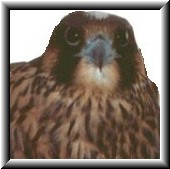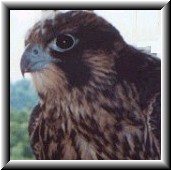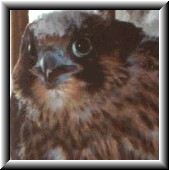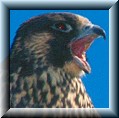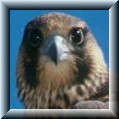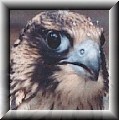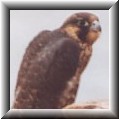Links: |
Location:
Lead Partner: |
LEEDS COUNTY HACK SITE REPORTS: |
Thursday September 1, 2005
Mark Nash reports: With fall just around the corner, reports have been streaming in that things have got very quiet at many of the urban nests sites, and with the absence of the juveniles, it is nice to see at least that many of the urban adults are still on territory, with reports of many of them still spending time on the nest ledges.
Now independent, and hunting on their own, it would appear that many of the juveniles have either moved on, or have dramatically expanded their hunting areas taking them farther away from the home territories. We remember years past, while very closely monitoring some of the peregrine nest sites, we witnessed the adults on more than one occasion actually chasing their offspring out of the territory as October moved in. It is believed that the adults reach a point that they will simply no longer tolerate the harassment for food from their offspring, (in addition to sharing the territory with the kids), and "encourage" their young to move on. Sooner or later, the urge move on overwhelms them, as in the peregrine release sites that we have been doing over the years, the juveniles simply stop returning to the hack boxes for the food being provided by the hack site attendants.
Tuesday July 26, 2005
Dwayne Struthers reports: Another first at the hack box this am. Lennox was sitting on the front
deck of the box bobbing his head up and down watching some thing below
the box. I was watching him through the spotting scope so as soon as he
left the box I reached for my bins. so I could follow him. He surprised
me by folding his wing and went into a stoop straight down to the lake
surface. He actually touched the lake surface with his talons when he
pulled out of the dive. He then circled and came in again and tried to
pick something out of the water. After several tries he finally gave up.
I couldn't see what he was after but I think it might of been a fish.
Maybe the Ospreys are giving him bad ideas.
Later he attacked two seagulls. The dogfight was serious enough that at one point a white feather floated down and they finally hit the water to avoid his attacks. He then tried a new tactic. He came in about a foot off the water and tried to get them to fly. They tried to avoid him with side rolls but eventually they took to the air. As soon as they were airborne he would climb above them and dive bomb them again. I've seen them attack seagulls before but it usually doesn't last very long. This time however he harassed the seagulls continuously for about 3 mins. and then Saunders showed up and joined in. This activity continued for about five mins. and appeared to be pretty serious. I don't think they were playing but they haven't quite figured it out yet but I think they are getting close.
Sunday July 17, 2005
Sue and Neil Ainsworth report: Morning
Neil and his friend Roger Lupton spent a few minutes fishing below the hack box this morning. As they scanned the area with binoculars, they were able, at some point, to find all three falcons.
Saturday July 16, 2005
Sue and Neil Ainsworth report: It was a mild, sunny, calm day. As we set up at Camp C around 6:45 am, we could hear screeching coming from the area of the hack box. We determined that one bird was on the hack box but before we could set up our scope and identify it, it took off - flying north - and landed in a dead pine tree just above the rock where the kids dive during the day. This bird was quite noisy!! Once we had the scope set up, Neil noticed a second bird on the hack box eating. It dropped its food over the side and stood looking at it for a few minutes. We were able to identify the falcon as Kilowatt. A glance at the dead pine revealed that the first falcon we saw was no longer there.
A few minutes later, there was a lot of screeching as the falcon from the hack box flew north and joined a second bird on the loose rock pile below the tent at Camp A. They seemed to be picking through the rocks - eating ants? greenery? Then, one of the birds few north, doubled around then kept flying north out of sight. We could hear two falcons calling and one of them did not appear to be the bird on the rocks who, at 7:30, was still eating. Neil saw some movement above the tent at Camp A - a falcon flying quite fast along the tree line and out of sight.
After inspecting the falcon on the rocks more closely with the scope, we determined that it was Kilowatt. She moved around in the rocks disappearing behind tree branches and reappearing. She flew south over the hack box and landed in an oak above the rectangular rock. She didn’t stay there long! She then flew, calling, north then circled and landed out of sight in the trees past the roof of Carlyle’s cottage.
A blue jay had been very vocal this morning and we were visited by a small flock of chickadees who hopped around the branches of the tree above our heads.
As we scanned the area, Neil noticed a falcon in the dead oak north of the hack box above the diving rock. We looked again and, no, there were two of them, one on a branch a little lower than the other. About 8:30, one of the birds in the dead oak flew to the hack box - calling loudly. A couple of minutes later, it flew north and into a live oak tree north of Camp A. It’s Lennox! We had a closer look at the falcon still in the dead oak tree and determined that it was Saunders. Very shortly after that, a falcon flew straight at us then veered south out of sight. We’re not sure if he landed on our side of the lake or crossed back across the water in the direction of Carlyle’s. As I tried to follow the falcon, Neil noticed another bird take off from the same vicinity as the falcon and also fly in our direction. It’s debatable whether the falcon was chasing the other bird, checking us out, both, or just flying.
Meanwhile, back in the dead oak tree, Saunders is still hopping around. We can hear falcons calling in the vicinity.
At about 8:40, someone arrived the feed the falcons. Saunders was still in the dead oak and didn’t seem to notice. As the gentlemen doing the feeding descended to the hack box with a newly filled water dish, two birds started calling - both in the dead oak tree. It’s Kilowatt and Lennox! The falcon feeder climbed back up the hill and left. Unlike the last time we watched, the falcons did not immediately return to the hack box. It was a few minutes later when Saunders made a very noisy return to the hack. The others did not react to his calls. About five minutes later, Saunders flew north, then south, disappearing over Carlyle’s cottage. He called and the others replied but didn’t move. A boat came almost to our location, turned around and left. As it left, one of the falcons in the dead oak flew north to the end of the point, circled and then flew south back to the dead oak. Lots of calling going on and this falcon now appears quite restless, climbing the tree and calling. Neil then saw the third falcon fly north from Carlyle’s cottage and land in a live oak.
At about 9:25, both the falcons in the dead oak flew south past Carlyle’s. The third bird took off from the live oak and followed them. They were really NOISY this morning. We could hear more calling but could no longer see anybody. About 10 minutes later, two falcons flew north past the hack box and then disappeared going west. A couple of seconds later, we were treated to quite an aerial dogfight and they flew back out over the water. They then landed down in the vicinity of Camp D. We watched as one of the two flew back across the water, over Carlyle’s cottage and landed in a live oak. All was quiet for about 10 minutes. Then, a falcon took off from the area near Carlyle’s, flew north past Camp A and landed in a tree. We located him in a dark leafed oak tree north of the hack box directly above the black rock face. Once he changed branches, we were able to identify him as Saunders.
The blue jays had been vocal all morning. Now we watched as several of them hassled Saunders over the course of several minutes. We could still hear falcons calling from south of the hack.
A boat went south and as it did, we could hear falcons calling. It became a regular occurrence over the course of the morning that, if a boat passed in front of their location, or if they could hear people’s voices (some cottagers were doing outside work this morning) they started screaming.
One of the falcons then flew out from the oak at Carlyle’s, flew a touch south and down toward the water. We could hear it calling but we couldn’t see it.
At 10:44, we hadn’t seen any birds in a while so we decided to call it a morning. Before we left the area, Neil noticed activity down by the water north of the hack. As we approached, we came up close and fairly personal with a falcon sitting on a branch about four feet from the water. It turned and looked at us, then flew south along the water out of sight.
Evening
We set up at about 6:35 pm at Camp C. We could hear falcons calling south of Carlyle’s but weren’t able to see anybody. A few minutes later we heard thunder and it started to rain. The falcons reacted a bit to the thunder. We decided to pack up but, before we left, we took a boat ride down to the area south of Carlyle’s. There in a tall dead oak, we found two falcons. The third was nowhere to be seen.
Wednesday July 13, 2005
Dwayne Struthers reports: Everything going great. Birds still coming to the hack box. Web site
looks great. Hope you are going to put up your photos of Gary and the
birds on the box. Everybody was impressed with the pics. and want to
know what kind of camera you were using. They are the best shots on the
box that we have ever had.
Tuesday July 12, 2005
Friday July 8, 2005
Sue and Neil Ainsworth report: Weather: cloudy, calm and mild
As we set up at Camp C at about 6:30 a.m., we could see Kilowatt on the roof of the hack box. No other birds were in sight and Kilowatt started calling. For the next while, she alternating between calling and eating. A heron flew over the hack box but Kilowatt did not react. About 7:45 we saw a falcon fly back in the direction of the hack box, land directly in front of our location at Camp C and then fly north again landing roughly where he was before. We saw a green band and identified the bird as Lennox. He took flight again, landing in a juniper bush just north of Camp C. He changed location a couple of times and finally landed on the rock face in front of Camp C and went for a stroll. We lost sight of him behind some juniper bushes for a while then he was up again landing on the hack box. There was a lot of noise from the birds. It seemed to us like they were chatting. Lennox and Kilowatt spent some time hopping around the roof and porch of the hack box. At one point, Lennox hopped inside and we saw a feather or a butterfly come out. A little later we noted he was eating. The falcons simply watched as two gulls flew by and they watched a moth’s progress as it flew around the hack box. Just as we decided to go for a walk, a ruckus started over at the hack box. Saunders had returned, flying in from the south! Saunders began to eat on the porch of the hack, closely watched by the other two falcons. After he finished his meal, he seemed rather restless, hopping around a lot, spreading his wings, flying from the porch to the roof and back. A couple of birds checked out the inside of the hack box very briefly. About 10:00, one falcon dropped off the hack to the base of the oak tree. The other two joined him about 20 feet south of the hack box in the juniper bushes. They appeared to be eating ants. A little later, all 3 birds became airborne chasing each other. One landed on the hack, another landed below the hack and the third decided to take a time out on the freezer. For the next couple of hours the birds went for short flights and then finally all three were seen in the junipers south of the hack box.
About 11:30, Dwayne went up to the freezer to feed the birds and they certainly gave him a raucous welcome as they flew in the direction of Carlyle’s. One bird landed on the roof of the hack, taking off again briefly when Dwayne ran back up the hill after feeding the birds. The falcon circled and landed north of the hack on the rock face. Jesse identified the bird as Saunders. We located a second falcon in the junipers south of the hack box. The third flew south past Carlyle’s and we haven’t seen it since. About 15 minutes later, we noted some flapping on the roof of the hack box. Camp A identified the bird as Kilowatt. A half hour later, Neil found a falcon north of the hack box sitting on an old rock next to a juniper. Jesse, one of the junior rangers at Camp A, tried unsuccessfully to get close enough to see it. The birds settled down and all was quiet for a good hour or so. About 1:40, vultures flew over getting a rise out of the falcons. By now, Kilowatt and Saunders had made it back to the hack box, each going in and coming out with quail. Lennox was still hunkered down on the rock north of the junipers, sunbathing. He finally ‘woke’ up and flew to the hack box about 2:00, loudly greeted by the other two. We saw him eating on the left side of the porch of the hack box. When we left for the day, Saunders was on the right side of the porch acting as ‘guard falcon’, Kilowatt was on the roof and Lennox was still eating on the left side of the porch.
Thursday July 7, 2005
Mark Nash reports: Release day
My arrival was met with excitement in the air, as the many watchers had been assembling since 8 am in the morning at the Charleston Lake marina docks to catch their boat taxi to various watch camps set up by the Leeds County Stewardship and used to position themselves to conduct the falcon watch.
While I was not late (this time), everyone was very eager to get these three young peregrines go wild and free. Likely, one of the last peregrine hack releases in Ontario, we were all filled with mixed emotions, both excitement and sadness. History in the making. Shortly after my arrival, we were met by Melissa from the Kemptville district office of the MNR.
With everyone in position, and much anticipation, Gary Neilson from the Leeds County Stewardship climbed atop of the hack box and pulled the bars. With the bars pulled, we all waited for the birds to appear. Approx. 15 minutes after the bars were pulled, the first juvenile appeared (identified as Saunders by his band number). Next was Lennox, and then Kilowatt. It took approx. 15 minutes for the three to exit the hack box. For the next 45 minutes, the birds all played and chased each other around the outside platform, to the roof of the hack box, back to the front platform of the box, roosting, and two actually laid down to take a rest.
A perfect release, and just what we all wanted to see, with each of the birds taking their time as they each exited the hack box.
Within the first 45 minutes, the first bird to take its first flight was Kilowatt, with a very strong flight, with a couple of passes over the hack box (and our observation tent). The second bird to fledge was Lennox with a similar good strong flight. Last but not least was Saunders.
My departure was delayed as one of the juveniles had landed on the top of the camouflage observation tent that we were sitting in. This was a first!!
At the time of my departure, all three birds had taken their first flights, and all the birds were in view of the watchers.
Sue and Neil Ainsworth report: I don’t think we have seen a release that went more perfectly! Perfect weather too - sunny, warm and breezy. Before they were released, the falcons reacted loudly to vultures flying overhead. From Camp C, we could see heads popping out between the bars looking around. When the bars were finally removed about 11:15, the first bird out was Saunders. He hopped around from rock to rock on the porch of the hack box. Not to be outdone, Kilowatt flew out onto the porch and up onto the roof. Lennox finally hopped out of the hack box and onto the roof. Lots of flapping going on for a while. The first bird to fly was Kilowatt who landed on a tree, did a balancing act on a branch that would not support her, flew north and then landed in a tree above Camp A. She flew south and then north and finally landed on the roof of the tent at Camp A.
After taking in the world from the porch of the hack box for about an hour and a half, Lennox flew north and landed in a tree above Kilowatt’s perch on the tent. Then he flew south and appeared to land in the rafters of Carlyle’s cottage. He moved around and we eventually lost sight of him.
Saunders finally took to the air, circled and landed back on the hack box. After a while, he flew off again in the direction of Carlyle’s cottage. For the next while, we watched as Saunders and Kilowatt flew from tree to tree, "quarreled" in the air but didn’t venture too far from the hack box; they seemed to stay between Camp A and Carlyle’s cottage. Eventually, Lennox landed down by Carlyle’s and Kilowatt flew back to the top of the tent at Camp A. It must have been a comfortable place because she stayed there for hours! As we were packing up to go for the afternoon, she flew into the trees on the rock face just below Camp A.
We returned about 7:35. Saunders and Lennox were both on the porch of the hack box tussling a little over who owns what rock. Kilowatt wasn’t visible to us but we were told she was on the rock face south of the hack by the flat rock About 10 minutes later, the falcons started calling. Kilowatt appeared on the roof of the hack. We didn’t see her land but Dwayne could see her picking up food. It was interesting to note the birds’ reactions to their surroundings. They simply watched as some grackles flew over but as an osprey carrying a fish flew over the hack they voiced their objection loudly. The falcons were quite noisy after that. Kilowatt circled the hack box a couple of times. We got the impression that the birds were not happy to be sharing their air space. We also wondered if all the calling indicated the birds felt it was feeding time. At about 8:45 all the birds were on the hack box and we called it a night.
Tuesday June 28, 2005
Dwayne Struthers reports: Everything going very well, birds are eating us out of house and home. Growing very quickly, and looking more and more like adult peregrines as each day passes. They have all settled into their new home very well.
Great front page article on the hack from the Recorder and Times newspaper the day after peregrine's arrival at the hack site.
(Webmaster's note:) The article referred to above has been posted to the Endangered Species Bulletin.
Wednesday June 22, 2005
Mark Nash reports: Arrival at the Hack Box - Charleston Lake Ontario
After picking up the young peregrine chicks from the avian vet, Tracy and I departed Toronto for Charleston Lake - the hack release site.
Arriving at around 12:45 pm, with clear sunny skies, we were greeted by our sponsors from Ontario Power Generation and the Leeds County Stewardship Council, along with a representative from the Charleston Lake Environmental Foundation. With much excitement from all, we left the vehicles and proceeded down the trail to the hack box. After a short orientation (and tour) of the hack site for our sponsors, we proceeded with the banding.
After the removal of the seamless breeder's bands that the peregrine chicks were shipped with, they were all re-banded with the bands supplied by Mr. Hunter of the Ministry of Natural Resources.
With Linda Halliday, Mike Kavanagh, Liisa Blimske, John McCann, and Ron Threader from the OPG, Dwayne Struthers representing both the Leeds County Stewardship Council and the Charleston Lake Environmental Foundation, and Tracy Simpson from the CPF on hand to help with the banding, the banding was completed in record time.
As the young peregrines were banded, they were also named by our OPG partners. "Kilowatt" - a 880 (plus) gram female, "Lennox" - a 660 gram male, and "Saunders" - a 570 gram male were carried down the hill to their new home in the hack box overlooking (and giving them an incredible view of) Charleston Lake. What a view indeed!!!
Photos of all were taken during this banding event.
All of the birds were very happy to be done with this entire procedure and were eager to investigate their new home. By the end of the day, each of young peregrines was more than happy to "gorge" on their fresh bird lunch that Dwayne had prepared for them.
It was a very special good day indeed, and we were all saddened to leave.
I wish we could have stayed.
For earlier reports, visit the Leeds County archives.
2004 Release in Leeds County June 28th/04- Report by Mark Nash
For 2004 reports, visit the 2004 Leeds County archives. |
|
2003 Release in Leeds County Four chicks arrived on June 25 for the Hack Release from the cliff site on Charleston Lake. The chicks were banded on June 26 at the Charleston Lake Association Office prior to their placement in the Hack Box. Volunteers from the Brockville area and the Leeds County Stewardship council will be coordinating and participating in the Falcon Watch.
For 2003 reports, visit the 2003 Leeds County archives. |
2002 Release in Leeds County Following the great success of the 2001 Charleston Lake release, the Canadian Peregrine Foundation and Leeds County Stewardship Network are pleased to be partners again at this location in 2002. Three young male anatum peregrine chicks bred in captivity were introduced to the Leeds County hack box on June 27 for release in mid-July. For 2002 reports, visit the 2002 Leeds County archives.
|
|
2001 Release in Leeds County The Canadian Peregrine Foundation, in cooperation with the Leeds County Stewardship Council, undertook a release of peregrine falcon chicks in eastern Ontario in the summer of 2001. Four anatum peregrine chicks were purchased from breeders by the Canadian Peregrine Foundation for release. One of the fledglings was equipped with a satellite transmitter to enable us to follow its movements over the coming year via Project Track-'em. For 2001 reports, visit the 2001 Leeds County archives.
|


